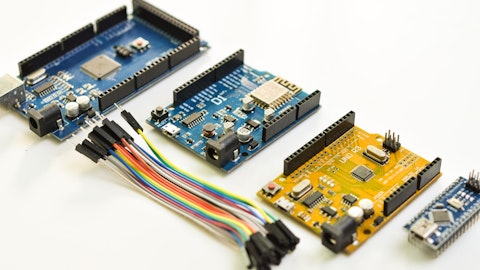Vicor Corporation (NASDAQ:VICR) Q3 2023 Earnings Call Transcript October 24, 2023
Vicor Corporation beats earnings expectations. Reported EPS is $0.37, expectations were $0.31.
Operator: Welcome, everyone to today’s webinar entitled Vicor Earnings Results for the Third Quarter Ended September 30, 2023. My name is Jono [ph] and I’m your producer for today. [Operator Instructions] I would like to advise all parties this conference is being recorded. And now, I would like to hand it over to Jim Schmidt, Chief Financial Officer. Please go ahead.
Jim Schmidt: Thank you. Good afternoon and welcome to Vicor Corporation’s earnings call for the third quarter ended September 30, 2023. I’m Jim Schmidt, Chief Financial Officer. And I’m in Andover with Patrizio Vinciarelli, Chief Executive Officer, and Phil Davies, Corporate Vice President, Global Sales and Marketing. After the markets closed today, we issued a press release summarizing our financial results for the 3 and 9 months ended September 30. This press release has been posted on the Investor Relations page of our website, www.vicorpower.com. We also filed the Form 8-K today related to the issuance of this press release. I remind listeners this conference call is being recorded and is the copyrighted property of Vicor Corporation.

An automated manufacturing production line of semiconductor components on an assembly line. Editorial photo for a financial news article. 8k. –ar 16:9
I also remind you various remarks we make during this call may constitute forward-looking statements for purposes of the Safe Harbor provisions under the Private Securities Litigation Reform Act of 1995. Except for historical information contained in this call, the matters discussed on this call including any statements regarding current and planned products, current and potential customers, potential market opportunities, expected events and announcements, and our capacity expansion as well as management’s expectations for sales growth, spending, and profitability are forward-looking statements involving risk and uncertainties. In light of these risks and uncertainties, we can offer no assurance that any forward-looking statement will, in fact, prove to be correct.
Actual results may differ materially from those explicitly set forth in or implied by any of our remarks today. The risks and uncertainties we face are discussed in Item 1A of our 2022 Form 10-K, which we filed with the SEC on February 28, 2023. This document is available via the EDGAR system on the SEC’s website. Please note the information provided during this conference call is accurate only as of today, Tuesday, October 24, 2023. Vicor undertakes no obligation to update any statements, including forward-looking statements made during this call, and you should not rely upon such statements after the conclusion of this call. A webcast replay of today’s call will be available shortly on the Investor Relations page of our website. I’ll now turn to a review of our Q3 financial performance, after which, Phil will review recent market developments, and Patrizio, Phil, and I will take your questions.
In my remarks, I will focus mostly on the sequential quarterly changes for P&L and balance sheet items and refer you to our press release or our upcoming Form 10-Q for additional information. As stated in today’s press release, Vicor recorded total revenue for the third quarter of $107.8 million, up 1% sequentially from the second quarter of 2023 total of $106.7 million, and up 4.6% from the third quarter of 2022 total of $103.1 million. Advanced Products revenue decreased 13.5% sequentially to $58.4 million, while Brick Products revenue increased 26% sequentially to $49.4 million. Shipments to stocking distributors increased 50.5% sequentially and 81.5% year-over-year. Exports for the third quarter decreased sequentially as a percentage of total revenue to approximately 62.8% from the prior quarter’s 68.1%.
For Q3, Advanced Products share of total revenue decreased to 54.2% compared to 63.2% for the second quarter of 2023, with Brick Products share correspondingly increasing to 45.8% of total revenue. Turning to Q3 gross margin. We recorded a consolidated gross profit margin of 51.8%, which is a 10 basis point increase from the prior quarter. I’ll now turn to Q3 operating expenses. Total operating expense increased 7.7% sequentially from the second quarter of 2023 to $40.2 million. The sequential increase was primarily due to R&D spending and an increase in legal fees, which will remain at substantial levels through the completion of the investigation by the International Trade Commission of the unlawful importation into the United States of modules and systems that infringe the asserted Vicor patents.
The amounts of total equity-based compensation expense for Q3 included in cost of goods, SG&A, and R&D was $693,000, $1,788,000 and $977,000 respectively, totaling approximately $3.5 million. For Q3, we recorded operating income of $15.7 million, representing an operating margin of 14.6%. Turning to income taxes. We recorded a tax provision for Q3 of approximately $1 million, representing an effective tax rate for the quarter of 5.9%. Net income for Q3 totaled $16.6 million. GAAP diluted earnings per share was $0.37 based on a fully diluted share count of 45,187,000 shares. Fully diluted EPS decreased approximately 3% sequentially compared to $0.38 in the second quarter of 2023 and increased approximately 825% from $0.04 per share earned in the same quarter a year ago.
Turning to our cash flow and balance sheet. Cash and cash equivalents totaled $227.8 million at Q3. Accounts receivable net of reserves totaled $62.6 million at quarter end, with DSOs for trade receivables at 42 days. Inventories net of reserves decreased 1.9% sequentially to $104.6 million. Annualized inventory turns were 2.1. Operating cash flow totaled $23.8 million for the quarter. Capital expenditures for Q3 totaled $7.7 million. We ended the quarter with a construction in progress balance primarily for manufacturing equipment of approximately $26 million and with approximately $16.7 million remaining to be spent. I’ll now address bookings and backlog. Q3 book-to-bill came in below 1 and 1-year backlog decreased 19.6% from the prior quarter, closing at $174.7 million.
Turning to the fourth quarter of 2023. With the reduction in backlog, including overdue backlog, we are more dependent on turns orders, and that results in less visibility to our near-term outlook. While that is the case, our current expectation is that revenue, gross margin, and operating expenses will be approximately flat sequentially. With that, Philip will provide an overview of recent market developments, and then Patrizio, Phil, and I will take your questions. I ask that you limit yourselves to one question and a related follow-up so that we can respond to as many of you as possible in the limited time available. If you have more than one topic to address, please get back in the queue. Phil?
Phil Davies: Thank you, Jim. Let’s begin with an update on our high-performance computing or HPC business, which will continue to be our major growth driver in the next few years. For the next few quarters, we will be focusing in 3 key areas. The first will be ramping production of our Gen 4 48-volt bus converter and factorized power point-of-load products in our new ChiP fab. The second will be completing development of our Gen 5 factorized power point-of-load solutions and delivering models and tools in Q1 of 2024. The third will be continuing to expand our customer base beyond the major accounts that dominated our revenues in the HPC market over the past 5 years. Regarding revenues in HPC, we expect customers using both lateral and lateral-vertical Gen 4 products to be in production through 2025 before introducing new processes, utilizing Gen 5 vertical power delivery or VPD solutions midway through 2025.
In reference to the expansion of our customer base, we have continued to have substantial discussions with large data center, AI, and network processor companies on their challenges in powering next-generation high-current products. All of these companies recognize they need scalable access to more adept power system technology to effectively address the technical and operational challenges of generative AI at scale. The one major technology challenge that is foremost in everyone’s minds and heard repeatedly was power density and power delivery. Power delivery to the processors, power delivery to the AI accelerator cards, and their rack systems. And last but not least, power delivery to the data centers while driving towards a carbon-neutral objective.
HPC customers are becoming aware that our current Gen 4 lateral-vertical solutions can reduce power losses in an AI-enabled data center by 1 to 3 megawatts while enabling high processor performance. Future processes will, however, require full vertical power delivery or VPD to continue power loss reduction. Vicor’s first-generation VPD solutions introduced in 2020 required complex stacked packaging to incorporate bypass capacitors in a gearbox layer due to insufficient current multiplier density. Putting their customers at risk, competitors are going down the same route with even lower current density based on multi-cell multiphase solutions running into greater mechanical and thermal challenges as they try to deploy VPD using thick, heavy, and thermally inept stacked packages.
Our Gen 5 MCM technology steps up current density by over 3x and reduces the multiplicity of bypass capacitors needed, eliminating a stacked capacitive layer and enabling a second-generation VPD solution to the power system requirements of the AI card that is thinner, more thermally adept, reliable and cost-effective. Customer engagements for our Gen 5 VPD solutions are happening at an accelerating pace. And our objective in coming quarters will be to secure significant design wins. In view of the current density and performance gaps enabled by our 5G solutions and evolving AI-powered system demands, I am confident that within a few years, we will gain a dominant share of the AI power system market. One of the major objectives in the design and development of our 5G product line was to have a scalable, low-cost, short-cycle time and vertically integrated ChiP fab with a short time frame for capacity expansion.
We will need this capability to meet the supply chain demands of our customers who are in 2 distinct groups at the moment based on different priorities. The first group where the priority is supply chain flexibility is focused on a multisource, multiphase VR technology, and the second group, where the priority is competitive advantage from product performance is focused on the power system attributes needed to enable superior AI. Due to competitive market forces, our belief is that the first group will soon embrace the level of innovation and scalability enabled by 5G power system solutions from a multiplicity of ChiP fabs. I am very pleased with our progress in other key markets, which are critical to developing a robust and flexible business portfolio of our own.
We have reached a very important milestone in our automotive business development, achieving PPAP qualification for 3 of our platform power modules for 800 volts to 48-volt power conversion, which enables production for these products in the second half of 2024. As in previous quarters, we continue to develop new collaborations with OEMs and Tier 1 suppliers who value lightweight, high-density power system solutions. These collaborations will enable design wins for 2026 production and beyond. Towards the end of Q3 and early into Q4, we have seen demand strengthen in our broad industrial, aerospace, and defense markets for both large OEMs and smaller customers who purchased through our channel partners. Demand in China remains weak for both legacy brick and Advanced Products.
And we have been shifting our focus in recent quarters towards the Korean and Asia Pacific markets, where we see new opportunities for our advanced power modules across a broad range of industries. Our new sales and marketing team in Japan has been making excellent progress, developing new pipelines of opportunity with large industrial automation accounts, and are on track to add significant revenues in the coming years. Momentum with our operational excellence initiatives continues with teams working on specific performance improvements with our top 100 customers. And with new products set to launch in Q4 and Q1 of 2024, we are on track to meet our OGSM goals. Customer visits from our top 100 accounts to view or audit our new ChiP fab have been averaging 1 per week in recent months.
This pace will pick up in 2024 as we ramp production and have the ability to host more customers. Visitors have left impressed with our new fab and its capacity and scalability. They understand their need to access our fab capacity for power systems with power density and performance attributes that cannot be supported by multi-source multiphase solutions that cannot keep up with our current density and PDN flexibility. They also understand our commitment to operational excellence that’s clearly reflected in the equipment, process, and systems of our ChiP fab. Thank you. And with that, we will now take your questions.
Jim Schmidt: Okay. Operator, we’re ready for questions now.
See also 40 Awesome Places to Retire on $3,000 a Month or Less and Top 15 Tech Trends In 2023.
Q&A Session
Follow Vicor Corp (NASDAQ:VICR)
Follow Vicor Corp (NASDAQ:VICR)
Operator: [Operator Instructions] And the first question is coming from Jon Tanwanteng.
Jon Tanwanteng: First one, I was just wondering how qualifications have gone at the new facility. Can you talk about when you’ll start shipping volume through the vertical plating capacity and kind of the initial demand that you’re seeing and the response that you’re seeing from customers?
Patrizio Vinciarelli: I think we had trouble hearing part of your question. Could you repeat it, please?
Jon Tanwanteng: Sure. I was wondering how the qualification process went for the initial customers for the new vertically integrated plating capacity and when you expect to start shipping volume on that new equipment.
Patrizio Vinciarelli: Okay. So as Phil pointed out in his prepared remarks, we’ve had visits at an accelerating pace, frequent visits, weekly visits. As he mentioned, these visits have generally gone quite well. Visitors are impressed with the equipment, the processes, the systems we put in place to achieve much shorter cycle time in scalable capacity. This is very evident to every visitor that has come through the fab. The fab at this point in terms of its vertical integration is what I would say essentially complete. But that’s not to say that all the equipment has been delivered and installed. The strategy that the operations team has pursued in terms of enabling initial capacity has been to get the core equipment with respect to our three-dimensional integrated packaging capabilities in place while deferring some of the other measures in order to facilitate some of the challenges by some of the vendors.
That automation is coming in and is getting installed over the next few months. But while we are, in effect, not totally done, we are done to a very large extent. We can, at this point, make complete units, including all of the three-dimensional package integration steps that are essential to our 4G products in terms of vertical integrating processes that have been outsourced as well as enabling our 5G platform capability, which has some very exciting new process steps.
Jon Tanwanteng: To be clear, are you already shipping or are you still in the qualifications and maybe finishing out stages of the facilities? Are you producing out of that piece that you’ve been working so hard to in-source over the last year or two?
Patrizio Vinciarelli: We are using it for some of our in-house needs, I would say, most of our in-house needs at this point. And beginning to selectively use it for certain customers who are seeking short cycle time and rapid turnaround to service their needs, but not on a mass scale yet.
Jon Tanwanteng: Just to follow on, Patrizio, when do you think the book-to-bill will start to creep back over 1 and do you see that your backlog is increasing again?
Patrizio Vinciarelli: Well, that could happen relatively soon. It could take a little longer. We’re not going to make any specific prediction. I think it’s a complex landscape, and there is a number of variables at play. So I think we need to be non-committal with respect to that.
Operator: The next question is coming from John Dillon.
John Dillon: I’m wondering if you can give us a little more color on the bookings. For example, how do the bookings look for the next couple of quarters? Are we going to see sequential increases in the bookings or do you expect them to be flat or down?
Patrizio Vinciarelli: We may see substantial increases. Again, we don’t want to be very specific because of uncertainties that are outside of our control. But there is a range of scenarios that include a pretty steep climb. But then again, it may take a while longer.
John Dillon: Can you just give us a little more color on that? What’s going on? It sounds like you could possibly see a nice increase in bookings. But — and I understand bookings, trust me, I really do. But can you just give us a little more color on that, that’d be helpful.
Phil Davies: So John, this is Phil. So as Patrizio said, it’s a complex landscape of older programs ramping down, newer programs coming up. There’s a whole host of things out there complex-wise in terms of the deployment of next-generation solutions. So as Patrizio said, it’s better to just take a little bit of a wait-and-see approach to that at the moment, given as I said, the complexities that we’re looking at.
John Dillon: I guess I understand that. The problem is there’s a bunch of people who are short on the stock and the shorts are running around saying, you guys aren’t going to see any bookings increase and you’re out of the GPU business. Maybe you can just answer that question a little bit better because they’re pretty vocal about the demise of Vicor, and they’re really betting against you and the company. So I’m just wondering if you can help us out a little bit here, give us a little color on what you see as far as GPU land is concerned.
Patrizio Vinciarelli: John, as you know, I think you’ve been an investor for a long time. We don’t run a company based on what the shorts might do or any near-term type of consideration. We take the long view. We are very committed. We believe we are in a very unique position, the only position that can support critical market needs. So that’s how we run the company, that’s how we operate. We’re not going to get into any debate regarding that, which to us is quite obvious with respect to the tenure of our technology, the need for it. The customers that are literally flocking to us in terms of their next-generation AI needs, it confirms what we believe and is objectively supported by numbers such as current density and PDN flexibility, and vertical power delivery capabilities that are without equal in the industry.



